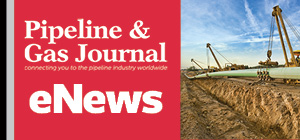
February 2025, Vol. 252, No. 2
Editor's Notebook
Editor-in-Chief Michael Reed examines how recent West Coast wildfires exposed vulnerabilities in fuel supply chains, leading to temporary pipeline shutdowns and regional fuel concerns. While quick action restored operations, the incident underscores the importance of pipeline resilience and emergency preparedness.
Government
The Biden administration’s attempts in its last month to make significant changes to pipeline regulation may be early targets for reversal for the incoming Trump administration.
Features
Europe is taking major steps to expand its gas pipeline networks to support gas flows from new LNG terminals. Germany, for instance, is planning to add 355 miles of pipeline over the next few years to accommodate new LNG imports, almost all of which will be high-capacity pipe, with diameters of 39 inches or greater.
In North Dakota, the nation’s second-leading energy producing state and third-best for oil, a three-member Industrial Commission (IC) headed by the governor oversees the state’s economy that is dominated by energy and agriculture.
Bakken pipeline expansion is underway, with projects addressing capacity constraints—especially for natural gas. Kinder Morgan’s $640 million acquisition in the Williston Basin adds to the momentum.
Among several different contracts for the Waukesha, Wisconsin, 36-mile pipeline and stations, one included 8.5 miles of water supply pipeline, with three horizontal directional drilling and eight tunnel crossings.
LNG is a key enabler of the global transition to a decarbonized energy system. It will play a pivotal role as companies move from coal and oil to cleaner energy sources.
The Alexandroupolis Terminal is a proposed floating storage and regasification unit (FSRU) import terminal in the Aegean Sea, off the coast of Greece. Back in February 2022, the national government of North Macedonia initiated a process by which it hopes to secure a firm supply of critical LNG flowing from the Alexandroupolis FSRU.
Oil and gas professionals need to be vigilant about potential hazards while striving to optimize performance and efficiency. This article explores critical safety and efficiency considerations and outlines best pipeline maintenance and operations practices.
(P&GJ) — Pipelines can accumulate deposits and debris, with fouling influenced by fluid composition, contaminants like hydrogen sulfide and heavy metals, and operating conditions such as temperature, pressure, and flow.
Tech Notes
ONEOK Inc., completed the MB-6, a 125,000-bpd NGL fractionator in Mont Belvieu, Texas, and the full looping of the West Texas NGL Pipeline system.
Projects
Explore the latest updates in pipeline and gas infrastructure, featuring new systems, expansions, and innovative developments shaping the industry. Stay informed on significant projects that enhance operational efficiency and drive growth in the energy sector.
Global News
Stay informed with the latest industry news and developments in the midstream sector. From pipeline projects to regulatory updates and company announcements, P&GJ's Global News column brings you the most important insights from around the world.

- Kinder Morgan Proposes 290-Mile Gas Pipeline Expansion Spanning Three States
- Valero Plans to Shut California Refinery, Takes $1.1 Billion Hit
- Three Killed, Two Injured in Accident at LNG Construction Site in Texas
- Tallgrass to Build New Permian-to-Rockies Pipeline, Targets 2028 Startup with 2.4 Bcf Capacity
- TC Energy Approves $900 Million Northwoods Pipeline Expansion for U.S. Midwest
- U.S. Pipeline Expansion to Add 99 Bcf/d, Mostly for LNG Export, Report Finds
- Enbridge Adds Turboexpanders at Pipeline Sites to Power Data Centers in Canada, Pennsylvania
- Great Basin Gas Expansion Draws Strong Shipper Demand in Northern Nevada
- Cheniere Seeks FERC Approval to Expand Sabine Pass LNG Facility
- Heath Consultants Exits Locate Business to Expand Methane Leak Detection Portfolio



